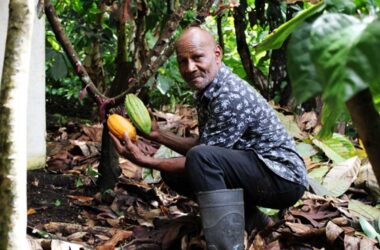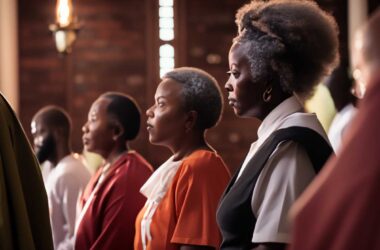
Throughout the ages weapons have been used on many occasions to inflict harm. After Adam and Eve chose death in the garden of Eden (Genesis 2:16,17;3:6) the lovingkindness of God was demonstrated by offering to cover their shame. Genesis 3:21 tells us that clothing of skin was made for the guilty couple but I wonder where the skin came from. Most students of the bible agree that it was the skin of an animal that was sacrificed. If this is the case, I try to imagine what weapon did they use to make the sacrifice? In Genesis 4:8 the event of Cain murdering his younger brother Abel is recorded. Jealousy led to rage and rage led to violence. The earth tasted human blood for the first time after a man was unable to control his emotions and lost his temper. I am curious to know what type of weapon Cain used. In the bronze age sticks and stones were common weapons in battle. In the iron age metal was the material of choice. Later guns entered the picture and now we have atomic bombs that could subtract five-hundred thousand souls from the living population quite easily. A weapon is commonly defined as something that is used to defend oneself against an enemy in a contest/battle. As knowledge has increased so has the sophistication of the devices we use to defend ourselves against real and imagined enemies.
In the contest between good and evil the Godhead continues to use the same weapon that has proven to be most effective: lovingkindness. Though the word has been translated good favor, faithfulness and mercy the original meaning of the term is covenant loyalty. This is the weapon that has never had to be improved because it is the only method that works against the enemy of fear, deception and selfishness. As a good doctor presents their sick patient with a remedy to cure their disease so does the Godhead work to heal us from the disease of sin.
In Romans 2:4 we are told “the goodness of the Lord leads to repentance.” Repentance (becoming convinced of our insufficiency and choosing to accept God’s sufficiency) is the end goal of our salvation and demonstrating unfailing kindness (goodness, love, mercy, etc.) is the weapon in the Godhead’s arsenal. We each have been infected with a corrupt programming (lies about God, ourselves and others) and desperately need to be rebooted (receive a new mind and understanding based upon eternal truth). Rather than using force and fear, the Godhead uses lovingkindness to persuade us that it is safe to forsake the false protection of fear, pride and selfishness that keeps us bound. It’s like the dog lover who carefully attempts to hand feed the dog who has been so abused that it no longer trusts getting close to humans. There could be no other weapon that dismantle the army of darkness within us because at our core we only need love and truth.
In John 9:1-3 Jesus showed that after we become convinced of God’s kindness toward us, we are to spread kindness to others. The NKJV states: “Now as Jesus passed by, He saw a man who was blind from birth. His disciples asked Him ‘Rabbi, who sinned that this man was born blind?’ Jesus answered, ‘neither this man nor his parents sinned but that the works of God should be revealed in him.” From this translation, it’s possible to think that God creates problems so that He could display His power to solve them but such is not the case. The Contemporary English Version translates verse three this way: “No, it wasn’t!” Jesus answered. “But because of his blindness, you will see God work a miracle for him.” It was common for Hebrews to think that bad things such as being blind were a curse from God due to someone’s sin. Jesus corrected this view and called the disciples to focus on expressing kindness, thoughtfulness and consideration towards the suffering in order to counteract the work of darkness.
A co-worker of mine shared with me about a time when a cashier at a restaurant paid for his meal after he realized he didn’t have any money. He told me, almost with tears in his eyes, that no one has ever cared for him like that before. Regardless of how long ago that happened, it had a lasting impact for good on his heart and that day he offered to gift me lunch. Being kind may seem trivial but in the battle of light versus darkness, it’s the fruit of holiness (Galatians 5:22) many are hungering for and all benefit from.












“After Adam and Eve chose death in the garden of Eden (Genesis 2:16,17;3:6)….”
It is truly dumbfounding that these three verses can be read over and over without revealing the entire exegesis of the world’s oldest mystery story, an exegesis that has remained hidden since the days of prehistory. Adam and Eve are allowed in Genesis 2:16 to eat the fruit from the tree of life while being forbidden in the following verse Genesis 2:17 to eat the fruit from the tree of life’s next-door neighbor tree in Genesis 2:9, the tree of knowledge of good and evil, which they end up eating anyway in Genesis 3:6. Everything is there in these three verses. But why has revelation been in chains since perhaps the very beginning?
Yes, they eat forbidden fruit from the tree of knowledge of good and evil. But what is an identity that can be considered for the forbidden fruit eaten in Genesis 3:6, and what is an identity that can be considered for the tree that produces this fruit? There is no reason why consideration of these two identities should not stimulate discussion, criticism, and evaluation of the validity of the following exegesis of the Genesis story. To repeat: what forbidden fruit gets eaten and what tree produces the fruit?
For thousands of years, the identity of the forbidden fruit eaten by Adam and Eve in the Garden of Eden story has been unknown. If the fruit is the traditionally believed apple, or another literal fruit, it would simply be called by its literal name, and not the fruit of the tree of knowledge of good and evil. Because eating a piece of this literal fruit would give only knowledge of the literal fruit’s taste, not knowledge of good and evil. So…
If literal fruit is not the fruit in the world’s oldest and greatest mystery story, then what is the fruit? Why are the two super secret trees assigned the mystical names “tree of life” and “tree of knowledge of good and evil?” Is the talking snake Evil Angel speaking words, or does the talk represent something more subtle? Could two men have yielded to Adam and Eve’s temptation? Why would a smart man and woman eat from a forbidden fruit tree, instead of from one that is NOT forbidden, especially when both “trees” are right next to each other in the center of the Garden? How is the couple’s disobedience of the very first commandment to be fruitful and multiply while in the Garden linked to their decision to make only fig leaf aprons, instead of complete clothing, in this incomprehensible narrative, with its guesswork of interpretations and its hints of sexual behavior?
A lone exegesis combines all six questions for one answer, using only evidence in the dreamlike Bible chronicle, for an intelligent and sensible explanation of the world’s oldest and greatest fruit mystery. This evidence in the Genesis 2 and 3 Bible story identifies the fruit as carnal pleasure. The solid evidence offers no support for historical fruit identity opinions. But, even with the evidence, is this unique exegesis the correct exegesis?
*****
Bad Day in the Garden
They eat the fruit, but what do they eat?
We lift the veil, for a wary peek.
Through a forest of mystery hiding it all,
We see a body, naked and weak.
“The Random House Dictionary of the English Language” defines allegory as “a representation of an abstract, or spiritual meaning through concrete, or material forms; figurative treatment of one subject under the guise of another.” It’s difficult to imagine a better definition than this one. But it’s even more difficult to imagine anyone making any sense of the second and third chapters of Genesis by taking everything in the two chapters literally. When was the last time someone went into a grocery store and bought some knowledge of good and evil fruit?
Although most elements in Genesis 2 and 3 represent something else, there are a number of facts in the story that can be taken at face value.
1. Adam and Eve have real human bodies.
2. Adam and Eve are not wearing any clothes.
3. God has forbidden them to do something.
4. They have disobeyed God.
5. God has punished them both for their disobedience.
The above five facts form the basis for the religious beliefs of many people who are not interested in allegories, and of many who are. But there is an all-important sixth fact, the knowledge of which would do no harm to anyone’s religious beliefs.
This BODY is the Garden in whose center grow
The two famous trees, but nowhere a weevil.
Here is the tree of life and the one
Of knowledge of good and knowledge of evil.
This sixth fact is the key that unlocks the door, opens it, and solves the mystery: both trees are in the center of the garden. This fact is so important that it is mentioned, not just once, but twice: Genesis 2:9 and Genesis 3:3. (In Genesis 3:3 the tree of life is not specifically mentioned, but we know it is there, because we were told it is there in Genesis 2:9.) Technically, both trees could not occupy the center of the garden at the same time, unless they were entwined. But, there is no evidence for entwinement here. What these two verses tell us, is that both trees are very close to each other.
Because the two trees are right next to each other
Care must be taken to avoid the one bad.
For the fruit of both trees is pleasure,
So the pleasure is there to be had.
To be fruitful and multiply eat from the first.
But eat from the second and no one conceives.
So here we go now: one, two, three–
Pleasure, shame, fig tree leaves.
God’s first commandment to Adam and Eve was to be fruitful and multiply. To be fruitful and multiply, eat from the first. But eat from the second and no one conceives. Adam and Eve eat from the forbidden second tree, and as a result, produce no children while in the Garden of Eden. Instead of engaging in the procreative process as commanded, they use, as a procreative organ, a delivery system designed for delivery, but not for delivery of children.
This material is not just a brain teaser, nor hopefully is it an example of sophomoric cleverness. It’s really quite simple: explanations of certain fearful mysteries buried in the story for thousands of years, have been exhumed by using verse, rather than prose, to more easily reveal these explanations. The quality of the verse is both irrelevant and unimportant.
Please note: some parts of the story are totally acceptable as both symbolic and literal narrative, at least up to a point. For example, the symbolic garden can be juxtaposed with a literal garden, complete with fruit trees. Other sections can be taken as literal accounts, extra material such as Genesis 3:20-21, in which Adam gives Eve her name and God shows compassion for the pair by clothing them in animal skins for warmth, before evicting them from the garden, symbolic and literal, into the graceless and cold outside world where they forfeit their gift of eternal life they would have had if they had eaten only from the tree of life. (Genesis 3:22)
*****
Preliminary Wrap
The Genesis story tells us in Genesis 2:9 and 3:3 both trees are in the center of the Garden. So the forbidden Tree of Knowledge of Good and Evil is right next to the allowed tree, the Tree of Life, and its fruit. If the forbidden fruit from the forbidden tree is literal fruit, the eating of this fruit would give only knowledge of the fruit’s taste, not knowledge of good and evil. But the covering of the genitals with fig leaf aprons following the eating of the “fruit” does indicate sudden acquisition of knowledge of good and evil, a knowledge that results in a certain type of shame. It is difficult to understand how eating literal fruit results in this type of shame. And it is difficult to understand how normal and necessary physical relations between Adam and Eve result in this type of shame, since the first and only specified commandment to them is to “Be fruitful and multiply” in the Garden, a commandment they disobey, because no children are produced until after the eviction from Eden, and after they have normal and necessary physical relations for the first time in Genesis 4:1. But their obedience is too late: guardian cherubim and a flaming sword prevent reentry into the Garden.
Adam and Eve execute a double disobedience when they eat of the forbidden fruit–they fail to procreate, by doing what they are forbidden to do. And they fail to procreate, by not doing what they are commanded to do. Both failures occur simultaneously. The fruit in the Garden of Eden is not forbidden carnal pleasure, but forbidden nonprocreative carnal pleasure–nonprocreative carnal pleasure derived from a specific forbidden physical act.
*****
Postscript: Traditional Identity of The Fruit Persists
The widespread belief that the fruit is an apple has its genesis in the 12th century, based on Saint Jerome’s earlier 4th century Vulgate translation, in which he substituted the later corrected “malum,” meaning “apple,” for “malus,” meaning “evil,” to identify the forbidden fruit Adam and Eve ate. And this error remains the apex identity reaching us in the 21st century, still based on no evidence for the existence of a literal fruit. But to end on a positive note, the acceptance of the evidence-based exegesis of the identity of the fruit in the world’s oldest mystery story is at last making headway, as increasing numbers of people manage to set aside the emotions and feelings spinning them in circles, and acknowledge–at least until a better exegesis appears–the evidence in the Bible story of the talking fruit snake. This long-forgotten exegesis explains everything as it superimposes the allegorical Eden Garden upon its literal counterpart. The exegesis offers enlightenment for the untrue and oft repeated, “Only God knows what fruit they ate.” Yes, a Deity would know what “fruit” they “ate,” but the evidence in the Genesis story reveals the Deity’s knowledge of the fruit’s identity to anyone who wishes to know, and has the courage to overcome their emotional resistance and uneasiness resulting from being exposed to this knowledge. Would this exposure be eating forbidden knowledge once again? Would a Deity want us to remain ignorant of the Genesis story’s meaning? No to both questions, because our garden is not their Garden–we are not living in the Garden of Eden’s state of grace. And secondly, the evidence in the story clearly tells us that Adam and Eve did not disobey the “be fruitful and multiply” Genesis 1:28 commandment for the purpose of acquiring knowledge of good and evil. Their acquisition of this knowledge was a byproduct of their disobedient behavior, which was to experience nonprocreative physical pleasure by eating allegorical fruit from the allegorical wrong tree in the center of an allegorical garden, while at the same time quite possibly living in a literal garden with literal fruit trees and literal snakes that do not talk to women.
*****
Just Another Doctrinal Neologism?
Is this exegesis beginning with Genesis 1:28, continuing through Genesis 2 and 3, and concluding with Genesis 4:1 just another neologism? No, it is not. If the exegesis is only another neologism, but not the exhumation and revelation of the original story, then not only do the individuals who first hear the story have absolutely no idea what the story means, but neither does the original storyteller. Imagine the storyteller saying, “Sometimes I just say things. I don’t know what they mean.” It is somewhat difficult to imagine this event happening.
If it does happen, then the original storyteller tells the story while having no understanding of the words being said, unless the storyteller decides to deliberately disguise and beautify the story, to hide its true meaning. This will certainly require complex ability, to intentionally mystify at the very dawn of human consciousness. It will also require the original listeners to not ask the original storyteller any questions about this new story–a story that makes no sense. So, the mystification probably happens later. And, of course, when it does, everyone will know the meaning of the entire story. For a while.
*****
Summary and a Question
They disobey the Genesis 1:28 commandment–the first commandment–to “be fruitful and multiply [in the Garden]” when they become one flesh incorrectly (Genesis 2:24) by eating from the wrong tree in the allegorical Garden’s center (Genesis 2:9).
The entire evidence-based exegesis is included in the preceding one-sentence summary. But why was this confusing allegory, whatever its meaning, constructed in the first place, as the original literal story most certainly came first, a story which confused absolutely no one, unlike the allegory into which it evolved?